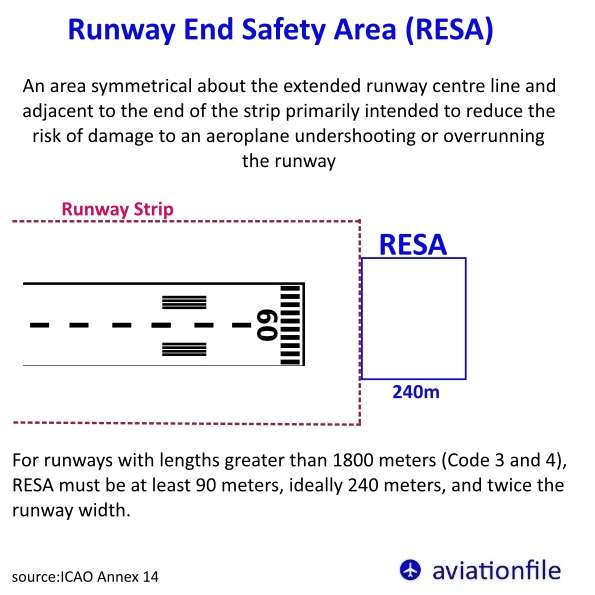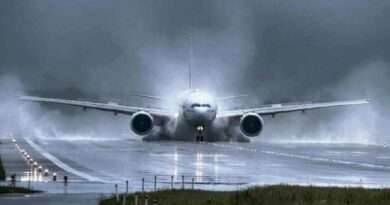What is RESA (Runway End Safety Area)? ICAO Standards and Its Critical Importance
Introduction: Why RESA Matters in Aviation Safety
In the world of aviation, safety is non-negotiable — and the Runway End Safety Area (RESA) is a crucial element designed to protect lives and aircraft in the event of runway overruns or aborted takeoffs. Often overlooked by the general public, RESAs are vital for mitigating damage when aircraft exceed the declared runway length.
According to the International Civil Aviation Organization (ICAO), all international airports must include a RESA at each runway end, and the dimensions of these areas are critical for compliance and safety.

What is RESA?
RESA (Runway End Safety Area) is a defined surface extending beyond the end of the runway strip, intended to minimize the risk of damage to an aircraft in the event of an undershoot, overrun, or excursion from the runway.
It is not designed for routine aircraft movement, but must be capable of supporting emergency operations such as rescue vehicles or an aircraft overrun.
ICAO RESA Requirements: Dimensions and Design
According to ICAO Annex 14 – Aerodromes, the recommended RESA requirements are:
- Length: Minimum 90 meters from the end of the runway strip.
- Preferred Length: Up to 240 meters, depending on aircraft types and operational risk.
- Width: At least twice the width of the runway.
Key Note: ICAO recommends 240 meters for higher-risk operations, but mandates a minimum of 90 meters.
Some national aviation authorities, like the FAA (U.S.), exceed this recommendation by requiring 305 meters (1,000 feet) for certain commercial operations under Part 139.
RESA vs. EMAS: What’s the Difference?
In airports where building a RESA is not feasible due to terrain or urban constraints, an alternative system known as EMAS (Engineered Materials Arresting System) may be used. EMAS is a crushable surface designed to safely stop aircraft by decelerating them rapidly.
- RESA: Passive safety zone, usually grass or compacted soil.
- EMAS: Engineered, active deceleration zone.
Many large airports (e.g., JFK, Madrid, Chicago O’Hare) use EMAS in place of RESA due to space limitations.

Real-Life Incidents Highlighting RESA’s Importance
Several aviation incidents underscore the need for a proper RESA:
- Air France Flight 358 (Toronto, 2005): The Airbus A340 overran the runway and ended up in a ravine. A longer RESA might have prevented extensive damage.
- Overruns at Congested Airports: Many regional airports have limited RESAs, increasing the risk of damage or fatalities in excursion events.
Design Considerations for RESA
- Load-bearing capability: Must support fire and rescue vehicles.
- Slope and grading: Gentle gradients to avoid further damage in overruns.
- Surface: Usually grass, sand, or stabilized soil — not paved.
- Obstruction-free zone: No structures or lighting equipment should exist in RESA.
Why Every Runway Needs RESA
A well-designed RESA:
- Saves lives during emergency overruns.
- Minimizes aircraft damage and operational disruptions.
- Enhances airport compliance with ICAO and national regulations.
- Supports rescue operations and post-accident investigation.
Conclusion: RESA is a Runway’s Safety Net
Although invisible to most passengers, the Runway End Safety Area (RESA) is an essential part of runway design that plays a vital role in aviation safety. Compliance with ICAO’s standards is not just a regulatory requirement — it’s a life-saving measure. As air traffic continues to grow, especially in congested or geographically constrained airports, proper RESA design and alternative solutions like EMAS will become even more critical.
FAQ About RESA
- Q1: Is RESA mandatory at all airports?
A: ICAO mandates a minimum RESA of 90 meters for international runways, but some countries impose stricter regulations. - Q2: Can an aircraft stop in RESA safely?
A: RESA is not paved, but it’s designed to reduce damage in case of excursions. - Q3: What happens if an airport lacks the space for RESA?
A: EMAS can be used as an ICAO-accepted alternative in such cases.
Keywords: RESA, Runway End Safety Area, ICAO runway standards, airport safety zones, overrun protection, aircraft safety area
Recommended: https://tc.canada.ca/en/aviation/reference-centre/advisory-circulars/advisory-circular-ac-no-302-015


